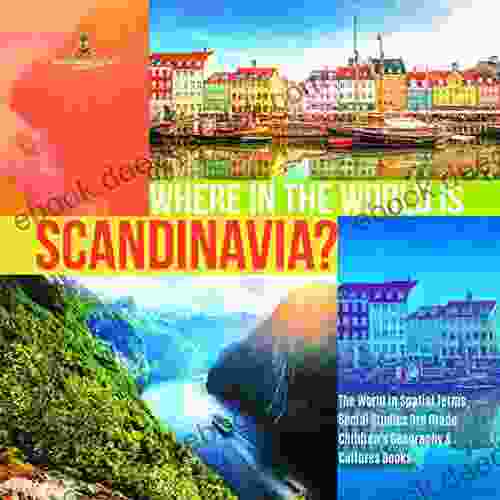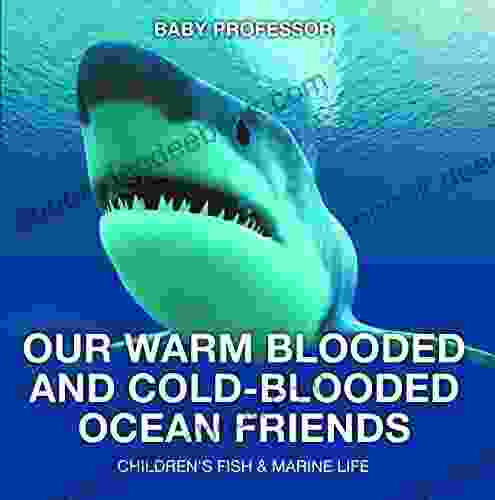Our Warm-Blooded and Cold-Blooded Ocean Friends: Children Fish Marine Life

The vast expanse of our oceans holds a captivating array of creatures, each with its own remarkable story. Among them, fish stand out as the most diverse and abundant vertebrates on Earth, showcasing a fascinating range of adaptations that allow them to thrive in the aquatic realm. In this comprehensive guide, we embark on an educational journey to explore the intriguing world of warm-blooded and cold-blooded fish, delving into their unique characteristics, habitats, behaviors, and the crucial roles they play in marine ecosystems.
Warm-Blooded Fish: Masters of Temperature Regulation
Warm-blooded fish, also known as endothermic fish, possess the remarkable ability to maintain a constant body temperature regardless of the surrounding environment. This extraordinary adaptation allows them to remain active and pursue prey even in cold and deep waters. Unlike cold-blooded fish, which are at the mercy of external temperatures, warm-blooded fish have evolved efficient mechanisms to generate and conserve their own body heat.
4.7 out of 5
| Language | : | English |
| Paperback | : | 374 pages |
| Item Weight | : | 1.92 pounds |
| Dimensions | : | 8.5 x 0.85 x 11 inches |
| File size | : | 2782 KB |
| Screen Reader | : | Supported |
| Print length | : | 42 pages |
Anatomy and Adaptations
Warm-blooded fish possess several anatomical and physiological adaptations that enable them to regulate their body temperature effectively. Their muscles contain a high concentration of mitochondria, the powerhouses of cells, which generate heat through aerobic respiration. Additionally, they have a specialized circulatory system that allows for efficient heat exchange between different parts of the body. Furthermore, some warm-blooded fish have a thick layer of subcutaneous fat that acts as insulation, preventing heat loss.
Habitat and Distribution
Warm-blooded fish are primarily found in colder regions of the ocean, where they can maintain their body temperature more efficiently. They are commonly found in deep waters, where the environment is relatively stable, or in areas with strong currents that provide a steady flow of oxygen-rich water. Some warm-blooded fish, such as tuna and swordfish, are highly migratory, traveling long distances in search of food and suitable habitats.
Behavior and Metabolism
Warm-blooded fish are known for their active and predatory behavior. They often engage in high-speed chases and have a voracious appetite. Their elevated metabolism, fueled by a constant supply of oxygen, allows them to sustain their energetic lifestyle. Some warm-blooded fish are also capable of leaping out of the water to escape predators or capture prey.
Examples of Warm-Blooded Fish
- Tuna: High-performance predators found in warm and temperate oceans.
- Swordfish: Long, sword-like bill and exceptional speed.
- Sharks: Apex predators with keen senses and powerful jaws.
- Billfish: Aggressive predators with long, spear-like bills.
- Marlin: Graceful and agile predators.
Cold-Blooded Fish: Adapting to the Environment
Cold-blooded fish, also known as ectothermic fish, rely on external sources to regulate their body temperature. They absorb heat from their surroundings, such as the sun or warmer water, and their body temperature fluctuates accordingly. This dependence on external heat sources limits their activity and distribution to warmer environments.
Anatomy and Adaptations
Cold-blooded fish have adapted to their ectothermic nature through various anatomical and physiological features. Their muscles contain a lower concentration of mitochondria, reducing their capacity for heat generation. Additionally, their circulatory system is less efficient at distributing heat throughout the body. Many cold-blooded fish have a thin layer of subcutaneous fat, providing minimal insulation.
Habitat and Distribution
Cold-blooded fish are predominantly found in tropical and subtropical waters, where the external temperatures are more favorable. They inhabit a wide range of environments, from shallow coral reefs to deeper oceanic regions. Some cold-blooded fish, such as salmon, have evolved migratory patterns to seek out optimal temperatures for spawning and feeding.
Behavior and Metabolism
Cold-blooded fish typically have a slower and more sedentary lifestyle compared to their warm-blooded counterparts. They often rely on camouflage and ambush tactics to capture prey due to their limited speed and agility. Their metabolism is also slower, allowing them to conserve energy in cooler environments.
Examples of Cold-Blooded Fish
- Salmon: Anadromous fish that migrate between freshwater and saltwater.
- Cod: Bottom-dwelling fish with a robust body and large liver.
- Trout: Freshwater fish found in cold, clear streams.
- Flounder: Flatfish that camouflage on the ocean floor.
- Pufferfish: Known for their ability to inflate themselves when threatened.
The Intricate Web of Marine Life
Warm-blooded and cold-blooded fish play vital roles in the intricate web of marine life. They form the foundation of food chains, providing nourishment to a vast array of marine organisms. Tuna, for example, are apex predators that hunt smaller fish and squid, while cold-blooded fish like cod provide a food source for larger predators such as sharks. Additionally, fish serve as cleaners, removing parasites and dead tissue from other marine animals.
The presence of fish also influences the health and biodiversity of marine ecosystems. Coral reefs, for instance, rely on herbivorous fish to control algal growth and maintain the delicate balance of the ecosystem. Mangrove forests, which provide shelter and food for many fish species, are vital for coastal ecosystems and shoreline protection.
Conservation and Threats
The vibrant world of warm-blooded and cold-blooded fish faces numerous threats. Overfishing, habitat destruction, and climate change pose significant challenges. Overfishing can deplete fish populations and disrupt marine food webs. Habitat destruction, such as coral bleaching and coastal development, reduces the availability of breeding grounds and food sources for fish. Climate change, through rising ocean temperatures and ocean acidification, can impact fish distribution, behavior, and survival.
Conservation efforts are essential to protect these diverse and ecologically important creatures. Sustainable fishing practices, the establishment of marine protected areas, and habitat restoration can help ensure the long-term health of fish populations and marine ecosystems. By taking proactive steps, we can preserve the delicate balance of our oceans and safeguard the future of our warm-blooded and cold-blooded ocean friends.
The captivating world of warm-blooded and cold-blooded fish showcases the remarkable diversity and adaptations of marine life. From the high-energy pursuits of tuna to the stealthy camouflage of flounder, each species plays a crucial role in the intricate web of our oceans. By understanding their unique characteristics and interconnections, we gain a deeper appreciation for the importance of conserving these fascinating creatures and their marine habitats. As stewards of the environment, it is our responsibility to ensure that our ocean friends thrive for generations to come.
4.7 out of 5
| Language | : | English |
| Paperback | : | 374 pages |
| Item Weight | : | 1.92 pounds |
| Dimensions | : | 8.5 x 0.85 x 11 inches |
| File size | : | 2782 KB |
| Screen Reader | : | Supported |
| Print length | : | 42 pages |
Do you want to contribute by writing guest posts on this blog?
Please contact us and send us a resume of previous articles that you have written.
 Book
Book Chapter
Chapter Story
Story Paperback
Paperback E-book
E-book Magazine
Magazine Newspaper
Newspaper Paragraph
Paragraph Sentence
Sentence Glossary
Glossary Bibliography
Bibliography Foreword
Foreword Preface
Preface Synopsis
Synopsis Annotation
Annotation Manuscript
Manuscript Scroll
Scroll Codex
Codex Library card
Library card Narrative
Narrative Autobiography
Autobiography Memoir
Memoir Reference
Reference Thesaurus
Thesaurus Resolution
Resolution Stacks
Stacks Archives
Archives Periodicals
Periodicals Research
Research Lending
Lending Reserve
Reserve Academic
Academic Reading Room
Reading Room Special Collections
Special Collections Study Group
Study Group Thesis
Thesis Storytelling
Storytelling Awards
Awards Reading List
Reading List Textbooks
Textbooks Stephen King
Stephen King Lydia Millet
Lydia Millet Ruth F Davis
Ruth F Davis Yves Lugrin
Yves Lugrin John Lamberton Harper
John Lamberton Harper Edward T Gilbert Kawai
Edward T Gilbert Kawai Julia Strekalova
Julia Strekalova Darrell J Ahrens
Darrell J Ahrens Jennifer R Ayres
Jennifer R Ayres Philip Parry
Philip Parry Dee Macdonald
Dee Macdonald Matt Wilson
Matt Wilson Victoria J Coe
Victoria J Coe Joy Ann Reid
Joy Ann Reid David Kelley
David Kelley Mike Bradwell
Mike Bradwell H Alan Day
H Alan Day Lee Ragans
Lee Ragans Hardy Jones
Hardy Jones Tarl Warwick
Tarl Warwick
Light bulbAdvertise smarter! Our strategic ad space ensures maximum exposure. Reserve your spot today!
 Howard BlairFollow ·5.4k
Howard BlairFollow ·5.4k Bryan GrayFollow ·18.9k
Bryan GrayFollow ·18.9k Braden WardFollow ·18.5k
Braden WardFollow ·18.5k Garrett BellFollow ·15.5k
Garrett BellFollow ·15.5k Michael CrichtonFollow ·4.3k
Michael CrichtonFollow ·4.3k Mikhail BulgakovFollow ·18.8k
Mikhail BulgakovFollow ·18.8k Wayne CarterFollow ·9.4k
Wayne CarterFollow ·9.4k Houston PowellFollow ·18.7k
Houston PowellFollow ·18.7k

 E.E. Cummings
E.E. CummingsThe Routledge International Handbook on Fear of Crime
Fear of crime is a serious problem that can...

 Fletcher Mitchell
Fletcher MitchellThe Hunchback in Hellenistic and Roman Art: A...
The hunchback, or kyphosis, is a physical...

 Victor Turner
Victor TurnerA Comprehensive Guide to Needle Felting for Moms:...
Needle felting, a captivating craft...

 Joseph Foster
Joseph FosterWhere is Scandinavia?
Scandinavia is a region in...

 Leon Foster
Leon FosterNovel Shades of Magic: A Masterpiece of Magical...
An Enthralling...
4.7 out of 5
| Language | : | English |
| Paperback | : | 374 pages |
| Item Weight | : | 1.92 pounds |
| Dimensions | : | 8.5 x 0.85 x 11 inches |
| File size | : | 2782 KB |
| Screen Reader | : | Supported |
| Print length | : | 42 pages |














